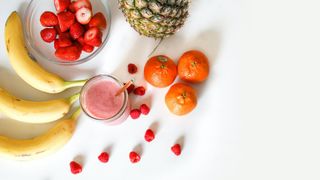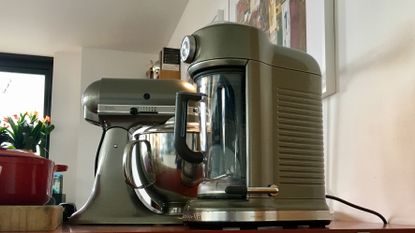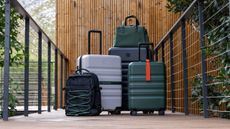Navigating the blender market can be a bit of minefield. Yes, we’re aware that sounds a little dramatic, but if you’ve ever tried to buy one, you’ll know how painful it can be. There are just so many to choose from, each touting their unique features, use cases and claiming to offer you something their rivals don’t.
Looking for the best blender to best mix your soups, smoothies, protein shakes and more is, therefore, not as straightforward as it should be. There are a lot of things to consider: will it be powerful enough to eradicate the lumps from my shake? Will it fit in my cupboard? Is it easy to use? Can I afford it? Is it easy to clean and dishwasher safe? Then, you have the arduous task of finding a product that ticks all your boxes. See! It’s quite the task.
That’s why we’ve put together this nifty guide, to help know what to look out for when shopping for your protein shake blender. So, when selecting the best for you, be sure to take a moment and consider the following factors...
Blender type: what's in the mix?
Why you can trust T3
When you’re picking out the best blender for whipping up your protein shakes, be aware that many brands won’t limit their designs to be marketed as solely “protein shake” blenders. Contrarily, some appliances will be bundled under the same ‘blender’ category, when in fact, they might have completely different use cases altogether. For example, some will be targeted towards smoothie making, while others more towards food processing, so you’ve got to be pretty vigilant. Here’s a list of the different types of blenders, to help you discern between them.
- Blenders: also often known as smoothie makers as that is what many people solely use them for, these are usually tall, slim and super powerful. They’ll crush ice and frozen veg like nobody’s business, giving you a fine liquid in minutes.
- Smoothie makers (compact): in contrast to blenders, these are marketed as being purely for one thing. Yes that's right: smoothie making. On these smaller blenders, the blending 'jug' is usually not a jug at all but a cup with a lid, that you can drink from right away or take to work or save for later. Despite the name, you can use better smoothie makers for blending all manner of other things. Our guide to the best Nutribullet contains several fine examples.
- Vacuum blenders: these suck the air out during the blending process to keep the ingredients inside fresher for longer. A nice touch, but not necessary unless you’re keeping the resulting mixture in the fridge for extended periods post-blend.
- Soup makers: these are blenders with smart, programmable features and the ability to heat ingredients, in order to make soups with the touch of a button.
- Hand blenders: also known as stick blenders and immersion blenders, these are – clearly – handheld devices that you lower in to a pan or jug filled with whatever you are intending to blend.
- Protein shake blenders are specifically designed for and marketed to those who want to blend protein powder into their fruit and veg treats. At the end of the day, they are just blenders though.
- Portable blenders are battery-powered blenders and not very powerful ones at that. They are popular with some users though.
- Food processors: a type of 'blender' that's actually more for chopping, mixing and dicing, although some will also turn their hands to blending.
- Note that many full-size blenders incorporate several of the above features in one unit. For instance, a lot of recent, premium blenders are able to heat soup at the same time as blending it.
So how do you know which is the best for blitzing solids into liquids? These capable kitchen devices will pummel protein, crush ice and pulverise fruits way better than you could ever do using your hands and a manual shaker, and also often tend to be more portable. This means you’re probably best off looking at those devices with smoothie-making abilities if you're unsure, and steer clear of larger food processors or low-powered portable blenders, as neither of these won't be fit for purpose.
Power: so watt right now!
Power is a super important feature when shopping for a protein shake blender. If it’s not powerful enough, your blades just won’t get your powered blend very smooth, no matter how sharp they are.
Power is determined in wattage, starting at around 200 watts for the portable versions, right up to more than 1,000 watts for those with more serious blending habits. Anything above 500 watts will suffice for most people's needs but if you want to make nut butters or mill flour you will need four figures.
Speed settings: you either got ‘em or you haven’t
Some blenders have multiple speeds, determined by RPM, but this can vary greatly between brands. Some shake and smoothie blenders don’t have the option as you just need the ingredients to be hurled around that jug as fast as possible. Those with multiple speed options are aimed at users wanting more control when blending floods, with different speed settings meeting the requirements of different solid ingredients.
Programmable smarts: not always necessary
More high-tone blenders, usually in the $200 /£200-plus price range, are likely to have programmes designed for specific tasks, such as soup or milkshake-making, ice crushing, etc. These make life easier if you’re planning to use your blender for a multitude of tasks, including more complex food preparation. If you’re wanting the appliance to double up as a soup or smoothie maker, it’s something to keep an eye out for.
The lack of a preset for a task doesn't necessarily mean that a blender can't do it, but if you buy a cheap one and it doesn't specifically say you can make nut butters or crush ice with it, you'd be well advised not to try that, as there is a danger of blunting the blades.
Cleaning: not always an easy task
Anyone who has ever owned a blender before will know what cleaning them can be a real pain in the cashew nuts. They can be fiddly to take apart and if you don’t clean them right after use, you’re setting yourself up for some pretty painstaking scrubbing later down the line. Some devices, like Nutribullet’s Pro 1000 Series, has an easy twist extraction blade release system, making it much easier to detach.
That’s another thing to look out for. If you’ve got a dishwasher and want to make use of it when it comes to cleaning your blender, then make sure the jug portion of the device is dishwasher safe. Most are, but it is very much worth checking.
A lot of blenders have self-cleaning programmes, or you can try placing detergent and water in the jug and whizzing it at full speed. It's advisable to hold the lid on when doing this.
Jugs: all shapes and sizes

Every blender has a jug. It might not be called this specifically by the company who makes it, but this is what we’re going to call it, for simplicity’s sake. The jug is basically the clear part where all your ingredients are thrown into and whirl around while they are blitzed into a fine liquid.
Some people consider the jug’s material to be the most important. This is because the plastic varieties, which are usually lighter and cheaper, can easily become scratched over time as well as absorb odours, and even stain. In this instance, glass jugs are preferred because they not only look better, but they’re also sturdier and likely to stand the test of time.
However, when it comes to protein shake blenders, it’s all about size. You want a jug that is more like a beaker shape, so it can be released from the motor base and drunk immediately, or at least thrown in your gym bag after your muscle-pumping weights session.
This means that larger, heavier glass jugs are not really suitable if it’s protein shake mixing you’re looking for. A good option instead is a BPA-free plastic jug, such as Tritan, which offers the best of both worlds. These are light yet strong, and even look like glass.
Price: it doesn’t have to cost the earth
Protein shake and portable blenders can set you back anything from a cheap and cheerful £20/$20. You can also go blend crazy and splash out on a £200/$200+ model from KitchenAid, Vitamix or Sage/Breville. We would recommend you spend at least £100 on a full-size blender. However there are some excellent compact Nutribullets that cost a lot less than that. Of course they also blend a lot less stuff, but if smoothies are basically all you want to blend, that probably is not going to be a problem for you.



